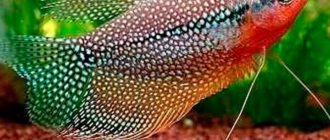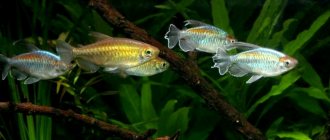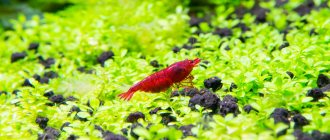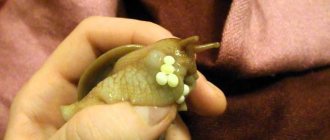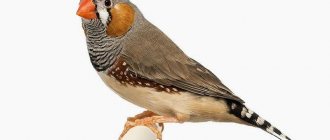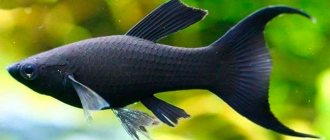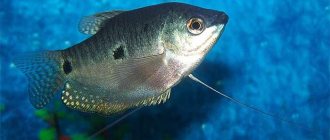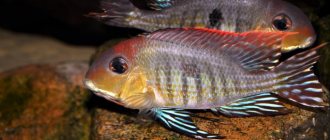Some labyrinth fish can make various sounds (slightly growl, croak, clap, etc.) and this species is no exception.
Most often, sounds can be heard during the spawning period or during fights for territory between males. Whether these sounds have any practical meaning is unknown. Requirements and conditions:
- Aquarium volume - from 140 liters.
- Temperature - 23–28°C
- pH value – 6.0–8.0
- Water hardness - soft to medium hard (5–19 dH)
- Substrate type - any dark
- Lighting - dim
- Brackish water - no
- Water movement - weak or standing
Fish parameters:
- Size - about 10 cm.
- Food - any
- Life expectancy - from 5 to 8 years
Habitat
Pearl Gourami comes from Southeast Asia. It was first discovered by European explorers in the mid-19th century. It lives in the territory of modern Thailand, Malaysia on the islands of Borneo and Sumatra. In recent decades, the wild population has declined significantly. However, the current situation does not threaten the aquarium fish market, since their mass production has been established in the Far East and Eastern Europe. In nature, Gourami is found in lowland swamps with acidic water, in rivers and creeks with dense vegetation, small ponds and lakes. They feed on various crustaceans, insect larvae and zooplankton.
Spreading
The islands of Sumatra, Borneo, as well as the lowlands of Vietnam, Malaysia, Thailand, and Indonesia are considered the homeland of pearl gourami. In nature, it lives in clean, shallow reservoirs with slow-flowing or standing water.
The ideal place for gourami to live is a natural reservoir, canal, stream with abundant vegetation and penetrated by the rays of the sun. Now the pearl gourami, which lives in nature, is listed in the Red Book.
This was led to by the expansion of human activity, environmental pollution, and disasters. On sale you can only find fish that are raised in specialized fish farms.
Description
The fish has an elongated oval shape, with a somewhat laterally compressed body. The dorsal and anal fins are elongated and become pointed in males. The pelvic fins are thread-like and extremely sensitive - this is an additional sensory organ with the help of which Gourami gets acquainted with the surrounding world. Like other representatives of labyrinths, it has the ability to absorb atmospheric oxygen directly from the air, while swallowing it at the surface. In the oral cavity there is a special organ penetrated by numerous capillaries - the rudiments of the lungs. The predominant body color ranges from brownish to red-brown with numerous light speckles/dots also present on the tail and fins. A brown lacy stripe stretches along the body, tapering as it approaches the tail.
Gourami diseases
The most common disease in gourami is lymphocytosis. This infectious disease is caused by a filterable virus. In a sick fish, hard formations appear on the surface of the skin and fins - lymphocysts, and copepods settle on the gills.
It is impossible to completely cure lymphocytosis. Lymphocytes on the fins are removed by cauterization. If the skin is damaged, the fish must be destroyed. After removing the infected fish, clean and disinfect the aquarium, completely change the algae, disinfect the soil and decor of the aquarium (keep in boiling water for half an hour).
In order to prevent lymphocytosis and other infectious diseases of aquarium inhabitants, purchased fish are quarantined. For this “newbie”, after purchase, it is kept for 7 days in a separate container (for example, a three-liter jar with aeration) and planted daily for 10-20 minutes in antiseptic solutions (methylene blue, bicillin-5 or oxytetracycline, rivanol).
Nutrition
The aquarium accepts all types of dry industrial food (flakes, granules). Many manufacturers have products specifically designed for Gourami. You can diversify the diet by adding bloodworms, mosquito larvae, as well as pieces of fresh vegetables (lettuce, spinach, cucumbers, etc.). Feed according to the instructions on the package if using specialized food. If other feeds are used, then 2 times a day. When adding meat products, feeding should be limited to once a day.
Feeding
Pearl gouramis are omnivores in the wild, feeding on crustaceans, insect larvae and zooplankton. In an aquarium, these fish typically eat all types of fresh, live, frozen, and dry flake foods. To maintain balance in the aquarium, gourami should be fed high-quality dry flakes or pellets as the main food, but additionally fed with tubifex, bloodworms, brine shrimp or any other suitable food. You can offer them fresh blanched vegetables or vegetable tablets.
They feed once or twice a day.
An interesting feature of these gouramis is that they can eat hydra, this miniature aquarium pest with poisonous tentacles. Hydras capture very small fish, paralyze them with poison, and, holding them with their tentacles, eat them. If you have hydras in your aquarium, get yourself pearl gouramis.
Maintenance and care
It is recommended to purchase a spacious aquarium of about 140–150 liters with a built-in lid. It allows not only to prevent the accidental entry of foreign objects, debris and dust into the water, but also contributes to the formation of a layer of air with elevated humidity and temperature. Such a layer reduces the risk of damage to the labyrinthine organ of fish when swallowing atmospheric air. The required minimum set of equipment is as follows: filter, heater, aerator and lighting system. The filter should provide effective cleaning, but at the same time create as little water movement as possible. In design, give preference to large plants with a strong root system, the optimal location is along the side and rear walls of the tank. Floating plants are welcome and provide additional shade. Place several shelters, hiding places in the form of grottoes, snags or artificial objects (a sunken ship, a castle, etc.), and their number should not be less than the number of fish. The substrate is preferably dark, the size of the soil particles is any.
Compatibility
They are very peaceful, even during spawning, which sets them apart from their relatives, such as marbled gourami. But at the same time they are timid and can hide until they settle in.
They are also not too lively when feeding, and it is important to make sure that they get food.
It is better to keep it with other peaceful fish. The best neighbors are fish that are similar in size and behavior, but keep in mind that other gourami species can be aggressive towards their relatives.
Angelfish can be good neighbors, despite some intraspecific pugnacity.
It is possible to keep cockerels, but they are unpredictable and pugnacious and may well pursue timid pearl ones, so it is better to avoid the neighborhood.
They get along well with neons, rasboras and other small fish.
You can keep shrimp with them, but only those that are large enough; cherries and neocardines will be considered as food.
They won’t eat too many shrimp, but if you value them, it’s better not to combine them.
Breeding/reproduction
Pearl Gourami breeds easily in a home aquarium. During spawning, males build foam nests and engage in fights among themselves. But they are not violent, injuries are extremely rare, the fish connect with their mouths and push each other. If there are more than two fish in the aquarium, then having an additional tank (quarantine aquarium) is highly desirable so that the fry feel safe and are not eaten. Spawning begins under a combination of the following conditions: the presence of dense plantings of root plants, a decrease in the water level to 15–20 cm, a temperature of 28°C and a pH close to 7.0, and the inclusion of meat products in the daily diet. After some time, the female begins to fill with eggs, and the male begins to build a nest from bubbles and pieces of plants. When the construction is completed, the courtship period begins - the male swims near the female, inviting her to the nest, while he fills with color and straightens his fins. Adults can produce up to 2000 eggs, which are carefully moved to the nest, where they remain under the protection of the male until the fry emerge.
Difficulty in content
The species is undemanding, adapts well to different conditions, lives quite a long time, about 8 years.
It eats any food, and in addition, it can also eat hydras that end up in the aquarium with food.
This is a great fish that can live in a community tank with many species. These fish can grow up to 12 cm, but are usually smaller - 8-10 cm.
They live a long time, and even show some signs of intelligence, recognizing their owner and breadwinner.
Despite the fact that pearl fish are quite large, they are very peaceful and calm. Good for community aquariums, but can be somewhat shy.
For maintenance, you need a densely planted aquarium with open areas for swimming.
Fish diseases and treatment methods
Pearl gouramis are hardy, but become susceptible to disease in cold water. If you find an individual whose appearance raises doubts about its health, transplant it into a separate container for quarantine.
Gourami most often get sick from non-compliance with the conditions recommended for their maintenance.
The causes of diseases are physical and chemical parameters of water and improper feeding. Often, gourami suffer from simple obesity: they should not be overfed at all . The most common problem is a common cold. When the temperature in the aquarium is about 26 degrees, and in the apartment it is 6-8 degrees less, the fish swallow cold air and catch a cold. It is not difficult to cure them if you do not delay. It is enough to raise the water temperature to the required values, and the gourami’s immunity will do everything itself.
Diseases can be caused by fungi, bacteria, viruses, various large or microscopic parasites. It is difficult to diagnose them without a specialist. The first steps, which will help in many cases, are to bathe the fish in a solution of potassium permanganate or table salt. There are several diseases that especially often plague these aquarium inhabitants.
Table: common diseases of pearl gouramis
| Name | Short description | Symptoms | Treatment |
| Lymphocystosis | A viral, extremely dangerous disease. |
|
|
| Pseudomonosis (fin rot) | An acute infectious disease. | Diagnosed by the formation of dark spots that quickly turn into red ulcers. | In a separate container without plants:
|
| Aeromonosis | A very contagious and difficult to cure disease, usually brought in with live food, which is facilitated by cold water and general unkemptness of the aquarium. |
|
|
Pearl gourami is a beautiful and interesting fish. Its maintenance and breeding is not easy and is not recommended for beginner aquarists. But once you gain enough experience, get this labyrinthine fish, which will become a decoration for your home pond.
Character and compatibility of marbled gourami
These are quite peaceful, leisurely and calm fish. They prefer to be in the upper and middle layers of water. Gourami are perfect for keeping in a community aquarium with fish of similar temperament and size.
It will be successful in proximity to minors, neons, rasboras, scalars, corydoras, ancistruses, and apistograms.
It is undesirable to populate them with mischievous Sumatran barbs and cocky swordtails, which have the habit of pulling Gourami's whiskers.
And marbled ones are absolutely incompatible with aggressive cichlids, piranhas and other predators, as well as with cold-water goldfish.
But for fry and small fish, these labyrinths themselves can be dangerous, as they can easily be mistaken for food.
Within a species, skirmishes between males can occur, but their outcome is always favorable. To avoid this, you can keep a couple of fish or two females and one male. If there is more than one male, then it is advisable to plant more plants and make shelters so that the weaker one can hide in them.
